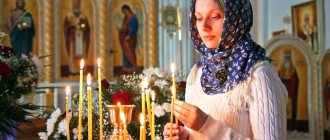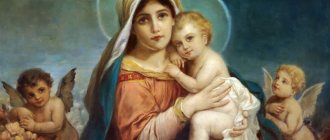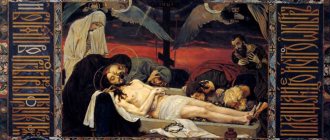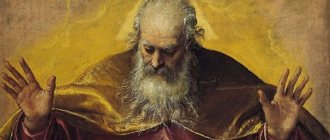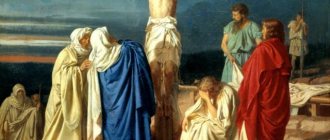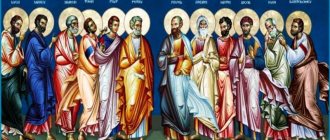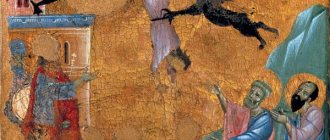Biography of Jesus Christ
Jesus Christ is the central figure in the Christian faith. For Christians, this person is the King of the world, one of the hypostases of God, the Savior who appeared in the flesh and atoned for the sins of people.
Image of Jesus Christ
The Bible says that he was a perfect, sinless, immaculately conceived God-man, a miracle worker, a healer, the head of the Kingdom of God he created, the Church, the founder and main character of a religious cult, who died, was crucified on the cross, and then resurrected. At the end of time, he will return to judge the world, after which all the saved will live and rejoice on Earth forever.
His life path and purpose are set out in the Gospels. In Islam he is recognized as a prophet, one of the messengers of Allah, in Judaism he is referred to as the False Messiah (since in the holy book of the Torah, one of the signs of the coming of the true Messiah is the end of all wars, the disappearance of evil and crime).
Reasons for Christ's oppression
After the resurrection of Lazarus, many Jews believed in the power of Jesus. Then the Pharisees and high priests decided to get rid of him. Answering the question why they killed Jesus Christ, it should be noted that the priests were afraid that the whole people would believe in him, and the Romans who came would finally take possession of the lands of Judea.
Then the high priest Caiaphas proposed to kill Christ. Jesus was tried under two legal systems: the Jewish, which was considered the fairest (it was built on the principle of equal punishment), and the Roman, which was based on the most perfect legal laws of that time.
In relation to Christ, the norms of Jewish law were violated, because arrest (according to them) was allowed only after an investigation. The only exception was a night arrest, when there was no time to conduct an investigation, and there was a danger that the criminal might escape. But in this case, the trial was supposed to begin the next morning.
Immediately after his arrest, Christ was brought to the house of the high priest Anna. The initial interrogation led nowhere. Jesus did not confess to the crimes, so the materials were transferred to the Sanhedrin for judicial investigation.
Childhood and youth
Jesus Christ, who became the second person of the triune God, was born in the period from 12 (at the time of one of the passages of Halley's Comet, which allegedly served as a prototype of the Star of Bethlehem) to 4 BC. (then King Herod of Judea died) in the family of an ordinary artisan, carpenter Joseph the Betrothed and the ever-virgin Mary, who came from the House of King David and lived in Nazareth (Northern Palestine). There is no exact date of the birth of Christ in the Bible.
Virgin Mary and Joseph
He was born not as a result of the intimacy of the spouses, but thanks to a miraculous conception through the Holy Spirit. The good news about the greatest event in the life of mankind - the future birth of a son, which became the fulfillment of Old Testament predictions about the coming of the Savior, was announced to them by the Archangel Gabriel.
Jesus is the modern sound of the ancient Hebrew name Yeshua. “Ieh” is the first syllable of the name of the Hebrew god Jehovah, and “shua” means “salvation.” Christ is the Greek equivalent of the Hebrew word “mashiach,” which means “anointed one.”
In the last months of pregnancy, the wives went to Bethlehem, where they were supposed to appear as part of the ongoing census. Due to the large crowd of people who arrived for the census, they could not find a place to stay for the night and were forced to stay in a cave-stable, where the Lord was born next to domestic animals. The newborn baby was glorified by a whole host of angels. Wise men from the East - the Magi - came to worship him. They brought gifts of gold, myrrh, and frankincense and told their amazed relatives that at night they received news of the birth of the Messiah, and a shining star showed the way to him.
Birth of Jesus Christ
On the eighth day, the parents performed the rite of circumcision, giving their son the name Jesus, and on the 40th day, sacrifices were made for the first-born boy in the temple of Jerusalem, where the pious Righteous Simeon blessed him. The meeting of humanity in his person with the Messiah began to be celebrated as the Presentation of the Lord.
Hearing about the mysterious baby, the vicious and cruel ruler Herod I, fearing to lose his throne, ordered the extermination of all male children under 2 years old in the city, hoping that Jesus would be among them. But the holy family, warned by an angel, managed to take him to Egypt.
Virgin Mary with baby Jesus
As the apocrypha testifies, after the death of the king, Joseph and Mary and their son wandered around Galilee. And everywhere they followed the glory of the boy’s miracles: the healing of the suffering, the pacification of wild animals. As a person, he grew up working, helping his father in carpentry. When he was 12 years old, his family visited the Jerusalem Temple with him on Passover. In a conversation with scribes, the teenager surprised them with his deep knowledge of the laws of nature and morality.
Judgment of Christ
The trial of Jesus began in the house of Caiaphas, where all members of the Jewish court who had the right to pronounce the death sentence gathered. The Sanhedrin met for this purpose. It included 71 people. It was to this body that the administration of Judea passed after the destruction of royal power. For example, only with the consent of the Sanhedrin could a war begin.
Jesus was charged with several charges: violating the word of the Lord, sacrilege, blasphemy. For the Sanhedrin, Christ became too strong and dangerous a rival. This explains why the Jews killed Jesus Christ. At the trial there was a lot of false testimony, to which the Savior did not respond in any way. The decisive question was Caiaphas's, whether Jesus recognizes himself as the Son of God. He declared that they were now seeing the Son of Man.
In response to this, the high priest tore his clothes, declaring that this was the main proof of blasphemy. The Sanhedrin sentenced him to death based solely on his words, violating another norm of Jewish legal procedure that no one can be convicted on the basis of his own confession.
Also, according to Jewish law, it was required that after a death sentence was pronounced, the accused should be sent to prison, and the members of the court would have to sit for another day, discussing the decision, sentence and the weight of the evidence. But the members of the Sanhedrin were in a hurry to carry out the sentence, so they violated this rule. It should now become obvious who killed Jesus Christ. The high priests were afraid of losing influence on the people, so it was important for them to stop the popular and beloved prophet. Here is the answer to the question why they killed Jesus Christ.
Moreover, the members of the Sanhedrin, having passed a sentence, could not carry it out themselves without confirming it with the Roman governor. That’s why they went with Jesus to Pontius Pilate.
Service
At the age of 30, Jesus came to the Jordan to be baptized. During the ceremony, the Holy Spirit overshadowed him, testifying to the favor of the Heavenly Father. From this moment, which became the feast of the Epiphany, Christ was recognized as the Messiah.
Baptism of Jesus Christ in the Jordan River
Then he went to the desert, where he spent 40 days in prayer, fasting and solitude and prepared to fulfill his destiny of atonement through self-sacrifice of human sins. There he fought with Satan, rejecting all his temptations.
Returning from the desert, Jesus began reading sermons, as well as transferring his knowledge to the 12 apostles. He spread the teaching about the Kingdom of God, interpreted Old Testament prophecies, and encouraged mercy, repentance, love, and acceptance of his personality.
To strengthen his faith, he also performed incredible acts - miracles. The first of them was the transformation of water into wine at the request of the mother at a wedding celebration. Subsequently, by the power of God, he healed the hopelessly sick, including the unfortunate leper, cured with one touch, raised from the dead, in particular, the daughter of Jairus in the presence of his parents and three beloved disciples (Peter, James and John), walked on water, stopped a storm on the Sea of Galilee, In an incomprehensible way, he fed 5 thousand people with five loaves of bread and ensured a miraculous catch of fish. All his miracles were imbued with care and deep compassion for people.
Jesus turns water into wine
The Lord instructed people, supplementing the 10 basic laws of Moses with his Beatitudes, the Golden Rule of Morality (about treating others the way everyone would like to be treated), a call not to judge, not to resist evil, etc.
The son of God's popularity grew, although he tried to avoid human glory. However, his activities were accompanied by constant clashes with representatives of the Jewish ruling and religious elite. For example, he denounced the Pharisees for their pride, high opinion of their own righteousness, and contempt for sinners. In addition, many people, languishing under the yoke of Roman rule, wanted Jesus to improve their earthly life. He offered them the salvation of their souls, the renunciation of everything worldly, and they, sick with anger and misunderstanding, considered themselves deceived. They were incited in every possible way to revolt by the Jewish high priests, who called Christ a “false prophet” and intended to deal with him.
Personal life
According to recent scientific research, which was picked up by writer Dan Brown, Jesus Christ was married. The discovered papyrus fragment with text mentions his wife Mary. Most historians agree that it is about the girl Mary Magdalene, who came from Magdala, which was located on the shores of Lake Gennesaret.
Meeting of Mary Magdalene and Jesus Christ
If we consider the non-canonical Gospel of Philip, written in the 3rd century AD, its text indicates that Jesus and Mary were “koinonos”. This word can be translated from ancient Greek as “partner,” which means that in this case both a spiritual and physical connection could be implied. This apocryphal text also stated that Jesus “kissed the lips” of Magdalene.
Jesus Christ and Mary Magdalene
After the execution on Golgotha, Mary stood with the Mother of God at the cross, and early in the morning she came to the tomb of Jesus to anoint his body with myrrh (fragrant oil). However, the angel reported that Christ had risen. She ran to tell the Apostle Peter about what had happened, thinking that someone had stolen the body, but when she returned, she saw the Savior of the world, who announced to her that he was ascending to the Father.
When did Jesus die?
Biblical sources agree that Christ was sentenced to death and crucified during the reign of the Roman procurator Pontius Pilate in Judea. The Gospel tells how the sky darkened for several hours after the crucifixion, which was perceived by witnesses as a miracle and an omen of future disasters.
Therefore, many historians associate the date of Christ's crucifixion with a total solar eclipse in 29 AD, which lasted approximately two minutes. Other researchers cite a longer eclipse (more than 4 minutes) in 33 AD.
Pilate addresses the crowd of Jews, calling for mercy on Christ / ©Painting by Antonio Ciseri/ wikimedia
Death and Resurrection
Recent events that brought the Lord emotional and physical pain are considered to be his passions. Among them:
- the ceremonial entrance on Sunday into the holy city, when he rode into it on a donkey (symbol of peace), greeted by the townspeople who covered his path with palm branches. And on Wednesday, Judas invited representatives of the highest religious institution - the Sanhedrin - to betray him for 30 coins;
- on Thursday, the Easter meal with the apostles (Last Supper), where he taught them the greatest example of love and humility, washing their feet, predicted the betrayal of one of them and the fate of the world, and also established the rite of Holy Communion;
- prayer in the Garden of Gethsemane, where he asked the Father to deliver him from upcoming suffering;
- arrest by the guards who burst into the garden with Judas. The traitor kissed him and thus betrayed his teacher to them. Late that night he was sentenced to death, found guilty of blasphemy;
- confirmation on Friday by the Roman governor Pilate of the unjust punishment. At first, he did not find the guilt of the righteous man worthy of execution, and in order to save the innocent, he offered to amnesty him for the sake of the holiday. But the people who gathered in the square chose the murderer Barabbas for pardon instead of the sinless God-man. Then Pilate ordered him to be beaten in the hope that the crowd, seeing him bloodied, would soften. But the desired did not happen, and he confirmed the verdict.
At about noon, the Savior was taken to Golgotha and crucified on the cross.
His dying suffering lasted about 6 hours. When he died, the earth shook and plunged into darkness. Crucifixion of Jesus Christ
The Jewish elder Joseph from Arimathea, together with another adherent of the teachings of Christ, with the permission of Pilate, took the Lord from the cross and buried him in a tomb that belonged to him, cut into the rock.
On the 3rd day after his death, the Son of God was resurrected. He appeared to Mary Magdalene and the apostles, talked with them, entrusting them with the dissemination of his ideas. On the 40th day, in front of the apostles, he ascended to heaven.
Resurrection of Jesus Christ
Henri Didon
III. THE YEAR OF JESUS' DEATH
In order to accurately determine the year of Jesus' death, you need:
1) prove that He was crucified on Friday;
2) prove that this Friday was the day of Passover, the 15th of Nissan.
Having proven this, all that remains is to cope with the astronomical table and the Jewish calendar and find at the end of the reign of Pontius Pilate the year when Easter fell on Friday. This year will be the year of Jesus' death.
The evangelists say quite definitely that Jesus was crucified on Friday. [end p.815]
Evangelist Luke (XXIII, 54), speaking about the burial of Jesus, which immediately followed His death, indicates His day and hour: “That day was Friday, and Saturday came.” The day that followed Friday and during which the women who were present at the burial of Jesus refrained from anointing the holy body of Jesus, although they had prepared spices and myrrh for this, the Evangelist Luke calls this day Saturday (XXIII, 56). Finally, the day when women go to the fob, carrying with them the aromas and incense prepared the day before, is called the first day after Saturday.
Evangelist Mark also calls Friday the day of the death of Jesus, and in order not to confuse Friday with the eve of Easter, he says specifically: “And how evening had already come (because it was Friday, that is, the day before Saturday (XV). “After the end Saturday", that is, on Saturday evening, the women bought spices to anoint the body of Jesus and on the first day after the Sabbath they go to the tomb (XVI, 1, 2). St. Matthew, speaking about the day that followed the day of Jesus' death, characterizes it in such expressions that leave no shadow of doubt: “The next day that follows Friday” (XXVII, 62).
So, the three synoptics agree with each other: it remains to compare with the fourth Gospel. The testimony of the Evangelist John completely coincides with the previous ones. Indeed, we read in Chap. XIX, 42: “They laid Jesus there because of the Friday of Judea, because the tomb was near.” And in the same chapter Art. 31: “But since then it was Friday, the Jews, so as not to leave the bodies on the cross on Saturday, for that Saturday was a great day [1], asked Pilate...” After the Sabbath, early in the morning, before dawn, Mary Magdalene comes to the tomb - the other day after the Sabbath is very clearly called by the Evangelist John (chap. XX) by the same name as the other evangelists, the first day after the Sabbath.
It is impossible to demand a more complete and perfect correspondence between all four Gospels, such as that indicated in these texts.
The conclusion is clear: Jesus died on Friday.
Secondly, it is necessary to prove that Jesus was crucified on the 15th of Nissan.
This follows from the very fact that He died on Easter Friday; and from the fact that the day before He, following the Jewish law, ate the Passover lamb with His disciples. The whole question [end p.816] is what kind of holiday it was: was it the Passover holiday when all the Jews were supposed to celebrate? If so, if the Passover meal was to be celebrated on the evening of the 14th of Nissan, it is certain that Jesus was crucified the next day, that is, on the very day of the feast, the 15th.
If we turn to the testimony of the first three evangelists, it is obvious that each of them speaks of the last supper of Jesus as the Jewish Passover: “On the first day unleavened,” says St. Matthew (XXVI, 17). St. Mark adds a more precise touch to this: “On the first day of unleavened bread, when they killed the Passover lamb” (XIV, 12). St. Luke clearly and directly speaks about the legal and obligatory nature of this holiday, the day of unleavened bread: “Now the day of unleavened bread has come, on which the Passover lamb was to be slaughtered” (XXII, 7).
The indications are too clear to suggest that this was an ordinary meal. The evangelists speak of the supper prescribed by the law, which was celebrated on the 14th of Nissan.
Some interpreters wanted to distort the meaning of the fourth Gospel, noting that St. John contradicts himself. Indeed, in ch. XIX, 14, speaking of the trial of Pilate, St. the evangelist adds: “Then it was the Friday before Easter.”
Instead of understanding this expression in the sense of Easter Friday, which in other cases might have meant Easter Eve, they assigned to it the latter meaning, Easter Eve, in a vain attempt to prove its authenticity on the basis of philology.
So, philology should in no way be inclined in favor of the interpretation of the words of St. John in the sense of preparation for the Easter holiday; and on the other hand, sound criticism should not accuse the author of contradicting himself, unless we are forced to do so by too decisive and irrefutable arguments.
Those who have contrasted the Synoptic Gospels and their so clear testimony with the testimony of the fourth Gospel in order to defend the position that Jesus celebrated His Last Supper on the 13th of Nisan and died on the 14th, the very day of the legal Passover, seem to have missed In view of the heated debate regarding the celebration of Easter, which filled the entire 2nd century. What did the bishops of Asia Minor with Polycarp at their head say? That Jesus kept the Passover on the 14th and died on the 15th of Nissan. What were they based on, if not on the testimony of the Evangelist John himself and the rest of the apostles? [end p.817]
How, therefore, is it possible to give the fourth Gospel an interpretation that contradicts the testimony of the first three, or which, in order to avoid obvious contradiction, forces the completely clear meaning of the text of the Synoptics to be distorted by arbitrary interpretation?
At St. In the Evangelist John there are only two places that gave rise to doubt and to which the defenders of the opinion referred that Jesus celebrated His last Passover on the 13th and died on the 14th of Nissan.
The first place (XIX, 14) is where John says that when Jesus was condemned by Pilate, “it was the Friday before Easter.” But we have already seen that this expression, from a linguistic point of view, could equally mean “Easter Friday” and “Easter Eve”; judging by the context of the speech, it means “Friday,” the very day of Easter.
Another place (XVIII, 28): “It was morning; and they did not enter the praetorium, so as not to be defiled, but so that they could pray to eat the Passover.” Therefore, the day Jesus was condemned by Pilate and put to death was on the eve of Passover, the 14th of Nisan.
The conclusion would be final if the expression “eating Passover” were limited only to the legal holiday of the 14th of Nissan. But since the word “Easter” previously meant only the evening of the 14th of Nissan, and in later times, as Josephus Flavius and the Talmudists point out, the whole day, from the evening of the 14th to the evening of the 15th, and even all 7 days dedicated to the celebration of the holiday, especially the evening of the 14th, as well as the 15th, 16th - 21st, then the expression “eating Easter” meant not only eating the Paschal lamb, but also voluntary sacrifices, "Chagiga", as the Talmud calls them - sacrifices that the pious Israelites, fulfilling the Law of Moses (Exodus, XXIII, 15, XXXIV, 20; Deut., XVI, 16), offered to the people on the days of the holiday and especially on the morning of the 15th Nissan.
It is unlikely that this expression, understood in the latter sense, which, however, does not in any way contradict the turn of phrase used by the Evangelist John regarding Easter (John, II, 13.23; VI, 4; XI, 55; XIII, 1), could give rise to to such an interpretation of the fourth Gospel, which would deviate far from the simple and consistent narrative of the first three evangelists [2]. [end p.818]
The year of Jesus' death should be placed in 783 from the founding of Rome and in the 30th year according to Christian chronology. Astronomy also confirms this.
Indeed, Jesus was crucified on Friday; all the evangelists agree on this, and equally the world tradition confirms this (Matt., XXVII, 1, 62; Mark, XV, 42; Luke, XIII, 54; John, XIX, 31, 42); this Friday was the day of Passover itself (John xix. 14) and therefore the 15th of Nissan. From this we must conclude that Jesus died in the year when Easter fell on a Friday. And astronomical tables, indicating the revolution of the moon from the 29th to the 33rd year, as the extreme years in which the death of Jesus can be attributed, prove that the 30th year was the only one in which the first day of Passover fell on Friday, the 15th of Nissan this year corresponded to April 7th. So, Jesus was crucified on April 7, 783 from the founding of Rome, or the 30th year according to Christian chronology.
PROBABLE DETERMINATION OF THE 15TH DAY OF THE MONTH OF NISAN from the 28th to the 36th year of the Christian era [3].
| DAY when the moon becomes visible | 15TH OF NISAN | ||
| 28 | March 15, 2:16 p.m. April 13, 4:10 p.m. | March 16 April 15 | March 30, Tuesday April 29, Thursday |
| 29 | April 2, 7:42 p.m. | April, 4 | April 18, Monday |
| 30 | March 22, 8 a.m. 8 p.m. | March 24 | April 7, Friday |
| 31 | March 12, 12:56 p.m. April 10, 2:00 a.m. | March 13 April 12 | March 27, Tuesday April 26, Thursday |
| 32 | March 29, 10:57 p.m. | March 31 | April 14, Monday |
| 33 | March 19, 1:16 p.m. April 17, 9:30 a.m. | March 21 April 19 | April 4, Saturday May 3, Sunday |
| 34 | March 9, 9 a.m. 2 a.m. April 7, 6 a.m. 42 p.m. | March 11 April 9 | March 25, Thursday April 23, Friday |
| 35 | March 28, 6:19 p.m. | 30th of March | 1 April 3, Wednesday |
| 36 | March 16, 5:53 p.m. April 15, 5:15 a.m. | March 18 April 16 | April 1, Sunday April 30, Monday |
[end p.819]
In addition to the Gospels, two historians - one Jewish, Josephus, the other pagan, Tacitus - boldly mention the death of Jesus and date it back to the reign of Pilate and the reign of Emperor Tiberius.
Speaking of the Christians, whom Nero, thanks to base lies and terrible slander, accused of a state crime, namely, the burning of Rome, and whom he subjected to the most refined tortures, Tacitus also adds that their common name - “Christians” - came from “ Christ,” condemned to death during the reign of Tiberius, when Pontius Pilate was the procurator of Judea (Annals, XV, 44).
“At the time when Pilate ruled Judea, Jesus was there. Rejected by the first of us, He was condemned and handed over to crucifixion by Pilate.” This is what the Jewish historian Josephus says in his famous interpretation, which criticism attributes to the hand of a Christian, but cannot deny at all (Ant., XVIII, 3).
So, Pilate ruled Judea from the 26th to the 36th year, therefore, the death of Jesus must be attributed to the same time indicated by the evangelist. The testimonies of pagans, Jews and Christians are all in complete agreement on this point.
[end p.820]
__________________
[p.816] 1. Author's italics.
[p.818] 2. It should also be noted that even giving the expression “to eat Easter” its literal meaning, our conclusion remains unshakable. The extraordinary influx of pilgrims did not allow all the Jews in Jerusalem to eat Passover on the same day; foreigners, like Jesus, celebrated the Passover supper on the 14th, and the inhabitants of Jerusalem had the right to celebrate it on the 15th.
[p.819] 3. Wurm., Astronomische Beitrage zur genaherten Bestimmimg des Gebnrts und Todesjahres Jesu, in Bengels Archiv.
